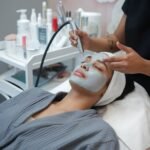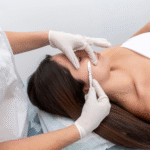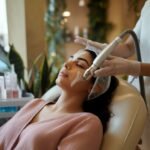How to Treat Red Stretch Marks: Causes and Treatment for Smoother Skin
- Home
- Mole, Wart & Skin Tag Removal
- how to treat red stretch marks

You might notice red stretch marks, or striae rubrae, as your skin rapidly stretches, commonly during pregnancy, puberty, or weight changes. These stretch marks occur when collagen and elastin fibers are disrupted, leading to visible linear scars. While some home remedies, like aloe vera, offer minimal benefits, clinical treatments—such as laser therapy and topical retinoids—are backed by evidence for reducing their appearance. Explore how to address these marks effectively for smoother skin.
Key Takeaways
- Red stretch marks result from skin stretching that disrupts collagen and elastin fibers, often due to rapid growth or weight changes.
- Maintaining skin hydration and a balanced diet rich in vitamins can prevent new stretch marks by enhancing skin elasticity.
- Laser therapy and microdermabrasion clinically reduce the appearance and redness of stretch marks.
- Topical retinoids promote cell turnover, aiding in the treatment and improvement of red stretch marks.
- Home remedies like aloe vera and coconut oil may offer minimal improvement but are less effective than clinical treatments.
What Causes Red Stretch Marks to Appear?
You may notice red stretch marks, or striae rubrae, as a result of rapid skin stretching that disrupts collagen and elastin fibers. This condition represents a different type of stretch damage that affects the skin’s structural components.
Weight gain often exacerbates this, causing increased tension on the dermal layer, particularly in areas like the thighs and stomach.
Hormonal fluctuations also play a critical role, influencing the skin’s resilience and making certain regions more susceptible to striae formation.
Common Causes of Red Stretch Marks
While often associated with pregnancy and rapid weight gain, red stretch marks, or striae rubrae, can appear due to various factors. The primary causes of red stretch marks involve the disruption of skin elasticity when the skin stretches beyond its limits. This overstretching impacts the dermis, one of the critical layers of the skin, leading to the appearance of these marks.
Here are some common causes:
- Hormonal Changes: Fluctuations in hormones, especially stretch marks during pregnancy or puberty , can weaken skin structure, making you more susceptible to developing red stretch marks.
- Genetic Predisposition: A family history of stretch marks increases your likelihood of experience stretch marks.
- Medications: Long-term use of corticosteroids can reduce skin elasticity, causing stretch marks can occur.
- Rapid Muscle Growth: Significant muscle expansion can force the skin to stretch quickly.
How Does Weight Gain Contribute to Red Stretch Marks?
When weight gain occurs rapidly, the skin’s capacity to stretch is often overwhelmed, leading to the formation of red stretch marks. As the body accumulates mass, the skin stretches rapidly to accommodate the increased volume.
However, the dermal layer’s elasticity can be compromised under sudden stress, causing microtears. These microtears disrupt normal collagen and elastin synthesis, which are vital in maintaining skin integrity.
As the skin is stretched, blood vessels become visible, contributing to the red appearance of stretch marks. This is a common cause of stretch marks, and they can appear in areas where weight gain is most pronounced.
Understanding these mechanisms is essential to recognizing how weight gain contributes to the development of red stretch marks.
Why Do Stretch Marks Appear on Thighs and Stomach?
Although the thighs and stomach are common areas for red stretch marks, their appearance is primarily due to the skin’s response to mechanical stress and hormonal fluctuations.
Stretch marks are common, such as the dermal layer tears during rapid growth or weight changes. This causes the skin to stretch beyond its capacity.
The following factors contribute to the development of stretch marks on these areas:
- Pregnancy: Hormonal changes and abdominal expansion cause the skin to stretch.
- Adolescence: Rapid growth spurts during puberty can lead to stretch marks.
- Weight Fluctuations: Quick weight gain or loss stretches the skin on the thighs and stomach.
- Corticosteroid Use: Prolonged use can weaken skin elasticity.
Understanding these causes and treatment options can help reduce the appearance of red stretch marks effectively.
How Can You Prevent the Appearance of New Stretch Marks?
To prevent new stretch marks, focus on maintaining healthy skin through adequate hydration and balanced nutrition.
While clinical studies show that certain topical creams may reduce their appearance, incorporating them into your skincare routine alongside healthy habits can be beneficial.
Prioritize regular exercise, as it promotes skin elasticity and may reduce the risk of stretch mark formation.
Preventing Red Stretch Marks: Tips and Tricks
While genetics play a significant role in the development of stretch marks, taking proactive steps can help minimize their appearance.
To support your skin and prevent the appearance of new stretch marks, focus on maintaining skin elasticity and health. Rapid weight changes are a common area of concern, as they increase the risk of stretch marks.
Here are some expert strategies to take into account:
- Hydrate: Drinking water guarantees skin cells are well-nourished, supporting elasticity.
- Balanced Nutrition: Consuming vitamins C and E, zinc, and silica promotes collagen production.
- Steady Weight: Avoid rapid weight fluctuations to reduce the likelihood of developing stretch marks.
- Moisturize: Apply creams rich in hyaluronic acid to areas likely to develop stretch marks for added hydration.
Employ these strategies to prevent stretch marks effectively.
Can Stretch Mark Creams Help Reduce Their Appearance?
Expert strategies for preventing stretch marks lay a strong foundation, but what if they’re already present? You might wonder if a stretch mark cream can help reduce their appearance.
While complete removal of stretch marks is challenging, certain topical treatments can improve stretch marks appearance, particularly red stretch marks. Active ingredients like retinoids and hyaluronic acid have shown efficacy in clinical studies, helping to smooth skin and reduce the appearance of stretch marks.
Consistent application of these treatment options may yield noticeable results over time. However, it’s essential to manage expectations; most creams won’t remove stretch marks entirely but can contribute to a more even skin texture.
Always consult healthcare professionals for personalized advice on effective treatment options.

Healthy Habits to Prevent Stretch Marks on the Skin
Although stretch marks can be a natural part of life, adopting healthy habits may prevent their formation. Understanding the possible causes, such as rapid growth or hormonal changes, especially during puberty, is essential.
Here are some evidence-based strategies to help prevent the appearance of new stretch marks:
- Maintain a Healthy Weight: Sudden weight fluctuations can lead to stretch marks. Gradual weight management helps reduce stretch on the skin’s layers.
- Hydration is Key: Drinking ample water maintains improving skin elasticity, which helps lower the chance of developing stretch marks.
- Nourish Your Skin: Use moisturizers containing ingredients like hyaluronic acid to fortify the layers of skin.
- Balanced Diet: Consuming foods rich in vitamins C, E, and zinc supports the skin health, potentially preventing stretch marks.
What Are the Best Treatment Options for Red Stretch Marks?
When considering treatment options for red stretch marks, you should evaluate both clinical interventions and home remedies.
Evidence suggests that laser treatments, like pulsed dye laser therapy, effectively reduce the vascularity and redness of stretch marks.
However, while some home remedies might offer minimal improvement, they generally lack the robust evidence seen with medical-grade treatments.
Top Stretch Mark Treatment Options Explained
Red stretch marks can be effectively managed through a variety of treatment options that target the underlying causes and improve skin appearance.
Evidence-based approaches emphasize clinical interventions and innovative technologies.
Here are the top four treatments for red stretch marks:
- Laser Treatment: This procedure stimulates collagen production, aiding in stretch mark removal and reducing the appearance of red marks, especially on the stomach.
- Microdermabrasion: A non-invasive technique that exfoliates the skin, promoting regeneration and visibly reducing stretch marks.
- Topical Retinoids: These compounds enhance cell turnover, greatly improving red stretch marks treatment outcomes.
- Chemical Peels: By removing the top skin layer, this method facilitates new tissue growth, treating stretch marks effectively.
These methods offer clinically proven results in treating stretch marks and improve skin texture.
Do Home Remedies Really Work for Removing Stretch Marks?
While clinical treatments for red stretch marks are effective, many wonder if home remedies offer a viable alternative. You can explore options like topical applications of aloe vera, coconut oil, and hyaluronic acid. These are known to help improve skin elasticity, potentially reducing the appearance of new stretch marks.
Thighs are a common area where these marks appear, and natural remedies might provide some benefit in improving the texture of stretch marks. However, evidence supporting their efficacy in making marks disappear is limited.
Self-massage can enhance blood circulation, possibly aiding in the treatment of stretch marks. While you mightn’t completely get stretch marks naturally, consistent application could help reduce the visibility of red stretch marks on your thighs.
Laser Treatment: Is It Effective for Reducing Red Stretch Marks?
Curiously, how effective is laser treatment in tackling red stretch marks? Laser therapies are clinically proven to help reduce the appearance of these red lines on your skin.
Treatments like laser therapy focus on stimulating collagen production, which can improve skin texture and tone. Red stretch marks may fade considerably, making your skin look smoother.
Here’s what you can expect:
- Fractional Lasers: These target small skin areas, reducing the appearance of red stretch marks by promoting new cell growth.
- Pulsed Dye Lasers: They specifically target blood vessels in red lines, helping them fade.
- Excimer Lasers: Useful for improving skin pigmentation and reducing red marks.
- Cost and Sessions: Multiple sessions may be required, and costs can vary.
Laser therapies can effectively transform how stretch marks look like, boosting your confidence.
How to Use Home Remedies to Treat Red Stretch Marks
To effectively reduce the appearance of red stretch marks at home, you can utilize evidence-based natural ingredients like aloe vera, which promotes collagen production, and coconut oil, known for its emollient properties.
Consider creating DIY stretch mark creams by combining these ingredients with others, such as shea butter, to enhance skin elasticity.
These home remedies offer a non-invasive approach, supported by dermatological insights, to manage stretch marks effectively.
Natural Ways to Reduce the Appearance of Stretch Marks
Although many people seek clinical treatments for stretch marks, several popular home remedies can help reduce their appearance effectively.
With red stretch marks, these treatments aim to make stretch marks fade and blend into the surrounding skin. Here’s how you can use home remedies to address marks typically caused by stretch marks:
- Aloe Vera Gel: Apply aloe vera gel directly on red stretch marks to soothe skin and support regeneration, helping marks naturally diminish.
- Coconut Oil Massage: Regularly massaging coconut oil can improve skin elasticity and potentially get rid of stretch marks over time.
- Lemon Juice: The natural acidity of lemon juice may lighten stretch marks, reducing their appear red effect.
- Hyaluronic Acid Cream: Topical creams containing hyaluronic acid are known to stimulate collagen production, aiding in the treatment of stretch marks.
Natural Ingredients That Help Reduce Stretch Marks Naturally
In addition to popular home remedies, certain natural ingredients have shown promise in reducing the appearance of red stretch marks.
Aloe vera, known for its soothing properties, may help make stretch marks less visible by promoting skin regeneration.
Shea butter, rich in vitamins A and E, can enhance skin elasticity, potentially preventing the change from red to white stretch marks.
Coconut oil, with its antioxidant properties, supports skin barrier repair, which may reduce stretch marks over time.
These ingredients address the skin’s collagen and elastin, whose disruptions cause stretch marks form.
As stretch marks are often the result of rapid skin stretching, incorporating these natural remedies could be beneficial.
Continuous application can lead to red stretch marks fading and improved skin texture.

DIY Stretch Mark Cream Recipes
Crafting your stretch mark cream at home can be an effective way to harness the benefits of natural ingredients.
By targeting red stretch marks, you aim to fade their appearance and make the skin look less purplish.
Here are four evidence-based DIY stretch mark cream recipes to contemplate:
- Shea Butter and Coconut Oil: Melt equal parts of shea butter and coconut oil; apply to your thighs daily for ideal treatment results.
- Aloe Vera and Vitamin E: Mix aloe vera gel with vitamin E oil; this antioxidant-rich blend supports skin regeneration.
- Cocoa Butter and Rosehip Oil: Combine cocoa butter with rosehip oil for enhanced skin elasticity and hydration.
- Beeswax and Almond Oil: Melt beeswax, then mix with almond oil to nourish and protect the skin barrier.
These recipes provide targeted treatment to help your stretch marks fade over time.
What to Expect When Stretch Marks Fade Over Time?
As you monitor the progression of your stretch marks, expect them to gradually transform from red to white over a period that varies based on individual factors such as skin type and how consistently the treatment is followed.
While there’s no exact timeline for fading, clinical studies suggest that with consistent intervention, noticeable changes can occur within several months.
To potentially expedite this process, you might consider evidence-based treatments such as retinoid creams or laser therapy, which have shown efficacy in accelerating skin regeneration.
How Long Does It Take to Get Rid of Stretch Marks and See Them Fade?
Although the journey to diminishing red stretch marks can be quite variable, understanding the timeframe and expected outcomes can provide clarity.
Stretch marks are red initially due to inflammation. Over time, these marks tend to become less prominent. Here’s what you can expect:
- Initial Appearance: Red or purplish stretch marks can appear suddenly due to rapid skin stretching.
- First Few Months: Stretch marks often start fading within 6 to 12 weeks, but stretch marks are not physically eliminated.
- 6 Months to a Year: Stretch marks will fade gradually, becoming less visible.
- Maintenance: Consistent skin care can enhance the fading process, making stretch marks appear less noticeable over time.
Patience and adherence to treatment are key to achieving smoother skin.
Do Red Stretch Marks Turn Into White Stretch Marks?
Initially, stretch marks appear red or purple due to the inflammation and blood vessels visible through your skin.
Over time, the inflammatory phase subsides, and collagen remodeling occurs. As the dermal layer heals, blood vessels constrict and reduce visibility, causing the marks to fade into a white or silvery appearance known as striae alba.
This shift is a natural part of the skin’s healing process.
It’s essential to understand that the fading from red to white marks a change in the skin’s condition but doesn’t imply that they’re disappearing.
While white stretch marks are less noticeable, they may become more challenging to treat, as they indicate matured scars where collagen has stabilized.
Can You Speed Up the Fading Process of Stretch Marks?
While red stretch marks naturally evolve into white ones over time, many seek ways to expedite this fading process.
Scientific approaches can support this transformation, enhancing skin appearance and texture. Here’s how you can potentially speed up the process:
- Topical Treatments: Use retinoid creams to enhance collagen production, fortifying dermal structure and promoting faster fading.
- Laser Therapy: Fractional laser treatments target the dermis, stimulating collagen and elastin synthesis, which is essential for stretch mark reduction.
- Microneedling: Induces controlled skin injury to boost collagen and elastin, facilitating skin repair and discoloration reduction.
- Chemical Peels: Glycolic acid peels accelerate epidermal turnover, improving skin texture and diminishing visible redness.
Each method varies in effectiveness; consider consulting a dermatologist to create a treatment plan tailored to your specific skin type.
Conclusion
To effectively manage red stretch marks, integrate evidence-based treatments like laser therapy and topical retinoids with consistent skin care. Prioritize hydration and a balanced diet to support skin elasticity. While home remedies like aloe vera and coconut oil offer minimal benefits, they should complement professional interventions. Over time, with proper care, you’ll notice fading as collagen and elastin regenerate. Remember, a proactive approach combining clinical and home treatments yields the best results.

Highly skilled cosmetologist at Tune Clinical Aesthetics, specializing in advanced skin and hair treatments.





